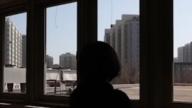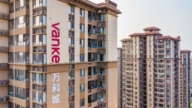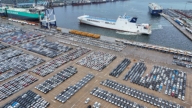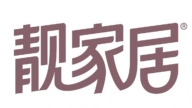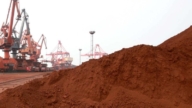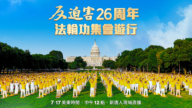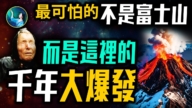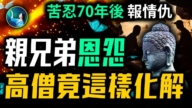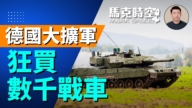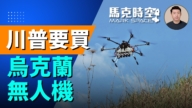【新唐人2013年07月23日讯】中国经济减速,是最近这周最受关注的经济新闻之一,再次引发了人们关注所谓的“中国模式”和中国的经济前景。中共几十年来采取的“中国模式”经济,带来严重问题,让中国经济处于转型的困境。而另一方面,“中国模式”中的因素,又在阻碍着这种转型。
国际货币基金组织(IMF),17号发布了有关中国经济的年度评估报告。报告警告说,中国实施经济改革已到了刻不容缓的地步。IMF并指出,中国现有的增长模式是“不可持续的,而且正在制造脆弱性”。
目前为止,中共所采用的所谓“中国模式”,是每当宏观经济出现问题时,威权主义的强势政府动员资源,海量的投入去救市。例如2009年的4万亿投资、10万亿贷款,把GDP增长率拉到8%以上。
不过“投资依赖”和“政府强势”,也正是所谓“中国模式”备受经济学者批评的两个痼疾。
中国国内的经济学家吴敬琏,曾多次抨击“投资依赖”模式的弊病。他指出,粗放增长在宏观经济层面造成的问题,是货币超发、债务积累,最后导致宏观经济波动和增长减速。然而政府反复使用这种模式,使得问题越来越严重,以至于现在中国维持人类生命的空气、水和土壤都发生了问题。
另外,对于“政府强势”的抨击,海外的经济学者则更加直白。
美国南卡罗莱纳大学艾肯商学院教授谢田﹕“中国的经济发展,如果说它有一种所谓的模式的话,它就是在一种高度的垄断和集权,加上暴力的专制,然后再加上资本主义原始的血腥。”
如果说在计划经济年代,中共控制经济导致了全民共同贫穷,那么在“六四事件”之后,为了延续岌岌可危的政权,中共在经济方面不得不做出的放宽,则催生了“社会主义市场经济”这个“四不像”的体制。
谢田﹕“中共,它又实行了市场经济,或所谓的走向资本主义经济化,开放了企业发展市场的路。但是它同时又保留了政治上的僵化,没有允许公平的竞争,自由的选举,和独立的媒体的出现。”
中共当局在许多领域直接参与了市场经营活动,一些垄断性的国有企业严重扭曲了市场价格和市场秩序。这一模式运行至今,中国的贫富差距达到了世界之最,官员权贵积累资本,大量外逃,而百姓却为基本的医疗,教育,住房等问题所困。同时,为了维持经济发展的数据,中国人还付出了无法计算的道德成本,和环境成本。
目前,“中国模式”几乎已经耗尽了中国的生产能力。国内外许多观察家都认为,中国经济增长将大幅度减缓,前景不容乐观。
近期“高盛集团”投资管理部发表报告分析,中国目前投资占GDP的比重过高且不可持续,已然超越了上世纪50年代末“大跃进”年代、以及90年代初投资过热时期。投资和GDP的比率早该下调,现已经逾期。
中国金融智库研究员 巩胜利﹕“这种投资啊,最麻烦的就是中国没有游戏规则,也没有可持续的法律环境。”
而“政府强势”的模式,也被认为将进一步加剧中国社会矛盾。
谢田:“因为共产党的官员他是不会停止他的步伐的。并且,只要他的贪心没有法律上的限制,并且他也意识到中共即将要灭亡,他不但不会放缓,他会加剧—-贫富悬殊,贫富分化继续加剧。老百姓的承受能力,和忍耐能力都是有限的。”
在“中国模式”走到临界点后,中共试图推动经济从“投资”转向“消费拉动型”模式。不过IMF在报告中表示,这一决定性转变“尚未发生”。
同时,尽管中共当局必须将“投资”转向“消费”,但银行却继续贷款给企业而不给个人。法国市场研究人员分析,这是因为中国的经济由中央控制,而政权十分腐败造成的。
采访/刘惠 编辑/尚燕 后制/肖颜
Economic Slowdown Shows “China Model" is Unsustainable
The economic slowdown in China has been
a focus of economic news this past week.
It again sparked concerns over the so-called “China model"
and China’s economic prospects.
The Chinese Communist Party (CCP)’s use of the
“China model" in the past few decades has led to serious issues,
forcing great difficulty upon China’s economic transition.
Additionally, factors within the “China model" itself
further impede this transition.
On July 17, the International Monetary Fund (IMF) published
its annual assessment report on China’s economy.
The report warns that China’s economic reforms
have come to a critical state.
The IMF also pointed out that China’s current economic
growth model is “not sustainable, and is creating vulnerability."
So far, the CCP has adopted the so-called “China model"
whenever there are macroeconomic problems.
It’s heavy handed authoritarian regime mobilizes resources
and invests massively to save the market.
For example, the 4 trillion yuan ($651 billion) investment
and the 10 trillion yuan ($1.6 trillion) loans in 2009 that
pulled the GDP growth rate to above 8%.
However, economists say “investment dependency" and
“Strong government” are two key problems of the so-called “China model”
Chinese economist Wu Jinglian has repeatedly criticized
the shortcomings of “investment dependency."
He says that extensive growth at the macroeconomic level
causes over issuing of money and debt accumulation,
which lead to macroeconomic volatility and growth slowdown.
However, the regime’s repeated use of this model makes
problems more serious.
It’s to the extent that now China even has trouble sustaining
human life, with problems arising with the air, water and soil.
Overseas economists are more straightforward to the
“Strong Government" aspect of the “China Model.”
Professor Xie Tian, University of South Carolina
Aiken School of Business: “If we say China’s economic
development follows a type of so-called model,
then it is one of extreme monopoly and centralized power,
combined with violent tyranny and primitive bloody capitalism."
If in the planned and controlled economy era,
the CCP’s control of the economy caused overall poverty,
then after the “June Fourth Incident" the CCP had to open up
its policy on economics to extend its precarious regime,
thus, it created a “Socialist Market Economy,"
which is neither fish nor fowl.
Xie Tian: “The CCP both implemented a market economy,
or the made its so-called move towards a capitalist economy,
and opened markets for enterprise developments.
But it also retained its political rigidity,
and didn’t allow fair competition, free elections,
and the emergence of independent media."
The Chinese authorities are directly involved in
many areas of market operations.
Some monopolistic state-owned enterprises seriously
distort market prices and market orders.
China’s current wealth gap is the world’s highest.
Officials and the powerful accumulate capital and run overseas.
People are frustrated with basic issues such as
health, education and housing.
Meanwhile, in order to sustain economic growth, China’s
people pay the price in terms of morality and the environment.
Currently, the “China model" has almost exhausted
the China’s production capacity.
Many domestic and foreign observers say that
China’s economic growth will slow down significantly.
The outlook is not optimistic.
Goldman Sachs investment management department
recently issued a report saying that
China’s current investment over GDP is too high and
unsustainable, already exceeding
that of the “Great Leap Forward" era of the 1950s
and the overheated investment period in the 1990s.
The time to lower investment and
the GDP ratio has also passed.
Gong Shengli, researcher at China’s financial think-tank:
“The most troublesome aspect of investment is that
China has no game rules, nor a sustainable legal environment."
The “Strong Government" model is also considered
to further escalate social conflicts.
Xie Tian: “The CCP officials would not stop their pace.
As long as there is no legal restrictions to their greed,
and with them also realizing that the CCP is about to perish,
they will not slow down and even hurry up.
Disparity of wealth between rich and poor will only get worse.
Meanwhile people’s endurance capabilities are limited."
When the “China Model" is at the edge, the CCP tries to shift
from the “Investment Model” to the “Consumer-Driven Model.”
But the IMF said in it’s report, this shift “has not yet occurred."
Meanwhile, despite the need for CCP authorities to shift from
the “Investment Model” to the “Consumer-Driven Model,”
banks continue to lend to companies instead of individuals.
French market researchers analyzed that this is because
China’s economy is controlled by a corrupt central government.


